We may earn revenue from the products available on this page and participate in affiliate programs. Learn More ›
|
Best Overall
|
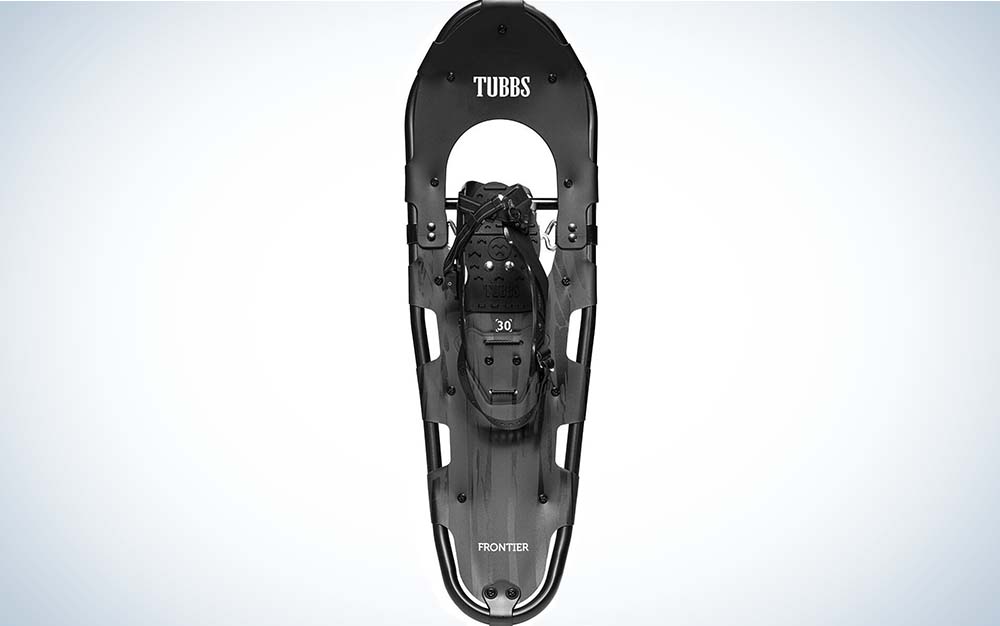
|
Tubbs Frontier Black 36
|
SEE IT
|
LEARN MORE
|
Summary
A great all-around snowshoe with great flotation and traction.
|
|
Best for Backcountry Trekking
|
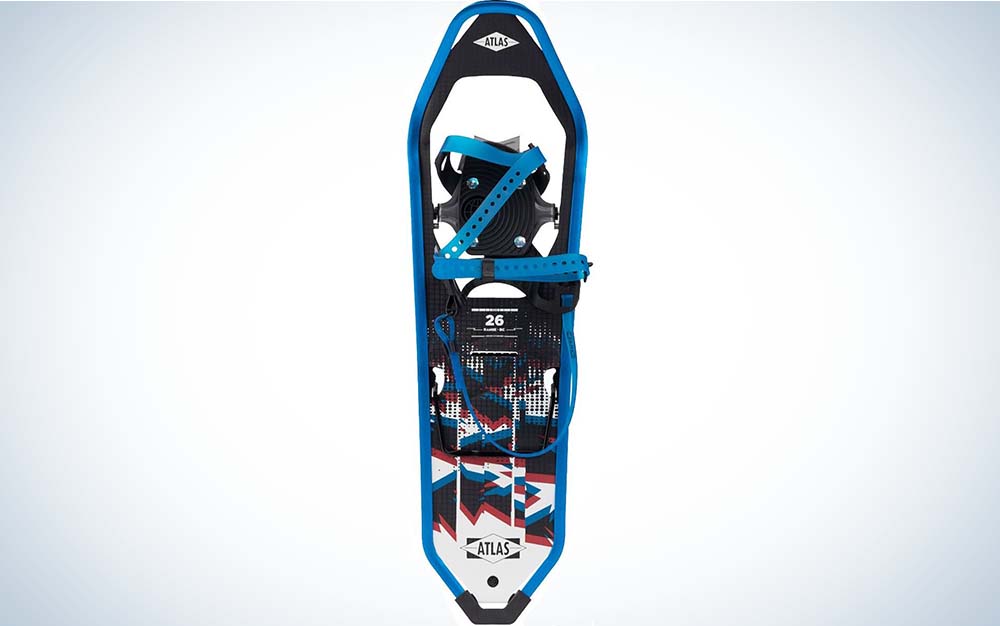
|
Atlas Range BC 26
|
SEE IT
|
LEARN MORE
|
Summary
They’re lightweight for deep treks, and the sawtooth frame provides great traction on steeper slopes.
|
|
Best for Kids
|
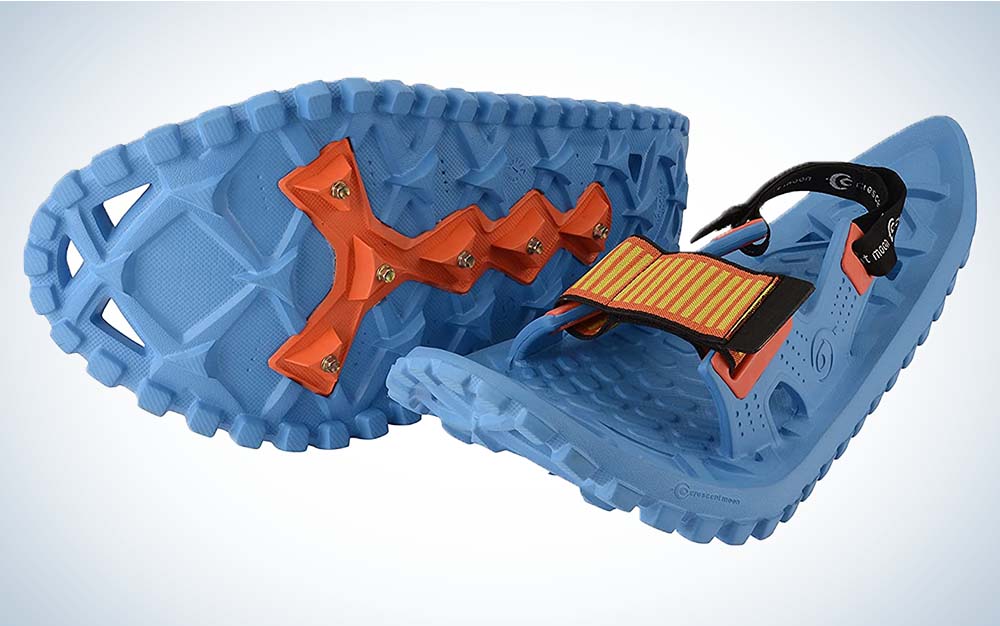
|
Crescent Moon Kids Snowshoes
|
SEE IT
|
LEARN MORE
|
Summary
Simple and easy snowshoes with good floatation for kids to have fun in.
|
Snowshoes have long helped travelers move through the deep powder, but modern snowshoers have a variety of needs and uses. You won’t see too many people on the trails with 6-foot-long wooden-framed, sinew-decked snowshoes, but designs like that have influenced modern snowshoe technology.
Rather than necessity, the best snowshoes are born out of recreational needs. You’ll still see classic-looking general-use snowshoes but also shoes adapted to climbing or racing, and the bindings sometimes look more like ski or snowboard bindings. Snowshoeing is an enjoyable way to see the backcountry in winter, but it has a learning curve. You’re more-than-likely to end up on your head with your feet tangled in the brush at least a few times—I was.
- Best Overall: Tubbs Frontier Black 36
- Best Bindings: Expedition Sno Spin Series Snowshoe Kit
- Best Backcountry Trekking Snowshoe: Atlas Range BC 26
- Best Running/Racing Snowshoe: TSL Outdoors Highlander Adjust 26.5
- Best Alpine Snowshoe: Snowfoot Olympus
- Best Budget Snowshoe: Komperdell Stoic 30
- Best for Beginners: Crescent Moon Eva Foam Snowshoes
- Best for Kids: Crescent Moon Kids Snowshoes
During my first snowshoeing experience, I ran a trapline for Marten here in Interior Alaska. Long treks through steep hills provided an educational and rewarding experience. Snowshoeing is great exercise, and once you get the hang of it, you just might like it.
Things to Consider Before Buying Snowshoes
There are shoes for trekking through deep powder, packed trails, and the steep alpine. The best snowshoes for you will depend on your goals. Big, general-use snowshoes won’t help you out if you’re a backcountry racer and running snowshoes aren’t designed to break trail through three feet of fresh powder. Some models have bindings made for sleek mountaineering boots, while others accommodate pack boots or other large snow boots. Keep your use, size, and the boots you use in mind.
Best Snowshoe Overall: Tubbs Frontier Black 36
Why It Made the Cut
The Frontier 36 is a fantastic snowshoe overall with great flotation. Its bindings are secure and easy to get in/out of, and they provide great traction in a variety of conditions. They are great for both breaking trail and walking snowshoe trails.
Key Features
- Length: 36 inches
- Weight: 2 pounds 11 ounces (each)
- Build: Aluminum tubing frame, synthetic deck
Pros
- Great flotation
- Easy, secure bindings fit large boots
- Simple, durable construction
- Short cramp-ons don’t hang up easily
Cons
- Not the best on steep slopes
- Not great for running
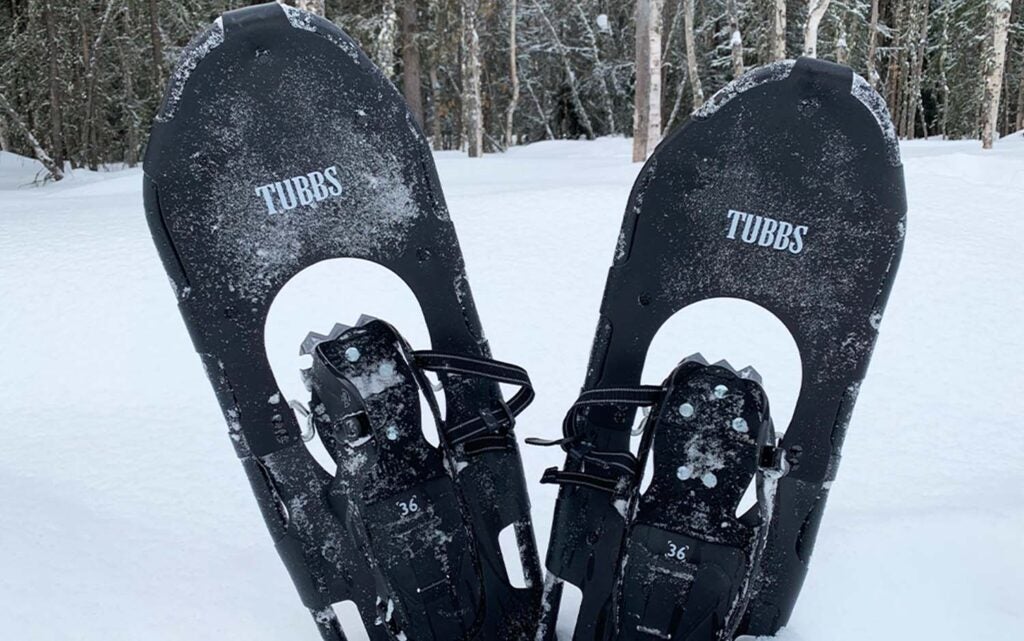
The Fronteir 36 is a great starter snowshoe that can tackle a lot of different terrain. Tyler Freel
The Frontier 36 is a classic snowshoe design with modern materials. The heavy-duty tubing frame surrounds a deck that consists of fabric in the rear and plastic in the front. They’re a simple and durable snowshoe that’s easy to use with big winter boots.
These are also designed to be a trail snowshoe, but their large footprint makes them great for breaking and packing trail in deep powder. They’re easy to maneuver in tight woods and not bad on hills, but the shorter cramp-on teeth can slip on steep, powdery slopes.
For the price, they’re a great basic snowshoe that can fill a lot of needs and great starter shoes, and for men over 220 pounds, this is the best set I tested for moving in deep snow.
Best Bindings: Expedition Sno Spin Series Snowshoe Kit
Why It Made the Cut
The Sno Spin is named for its BOA style bindings. These matched with the set-it-and-forget-it elastic heel straps make these snowshoes easy to put on and take off.
Key Features
- Length: 22 inches
- Weight: 2 pounds 2 ounces each
- Construction: Aluminum sawtooth frame, XPE Sno-Flex decking
Pros
- Lightweight
- BOA style bindings
- Heel lift for steep climbs
- Sawtooth aluminum frame
Cons
- Articulating toe bar can make backtracking difficult
- Bindings could be prone to failure
The Sno Spin’s dual deep-bite crampons and aluminum sawtooth frame provide extra traction in versatile conditions. There is also an articulating toe bar connecting your crampon to the frame allowing your foot a large range of motion to adjust to varying terrain. This feature is great for inclines or spotty coverage, but if you have to back up, it can be a hassle because the heel of the shoe will dangle when you lift your foot.
BOA-esque bindings secure your boot by simply spinning a dial. While this is highly convenient and stayed tight during my hike, they do tend to fail more easily. But there’s no quicker and easier way to put on or take off snowshoes.

Ashley Thess
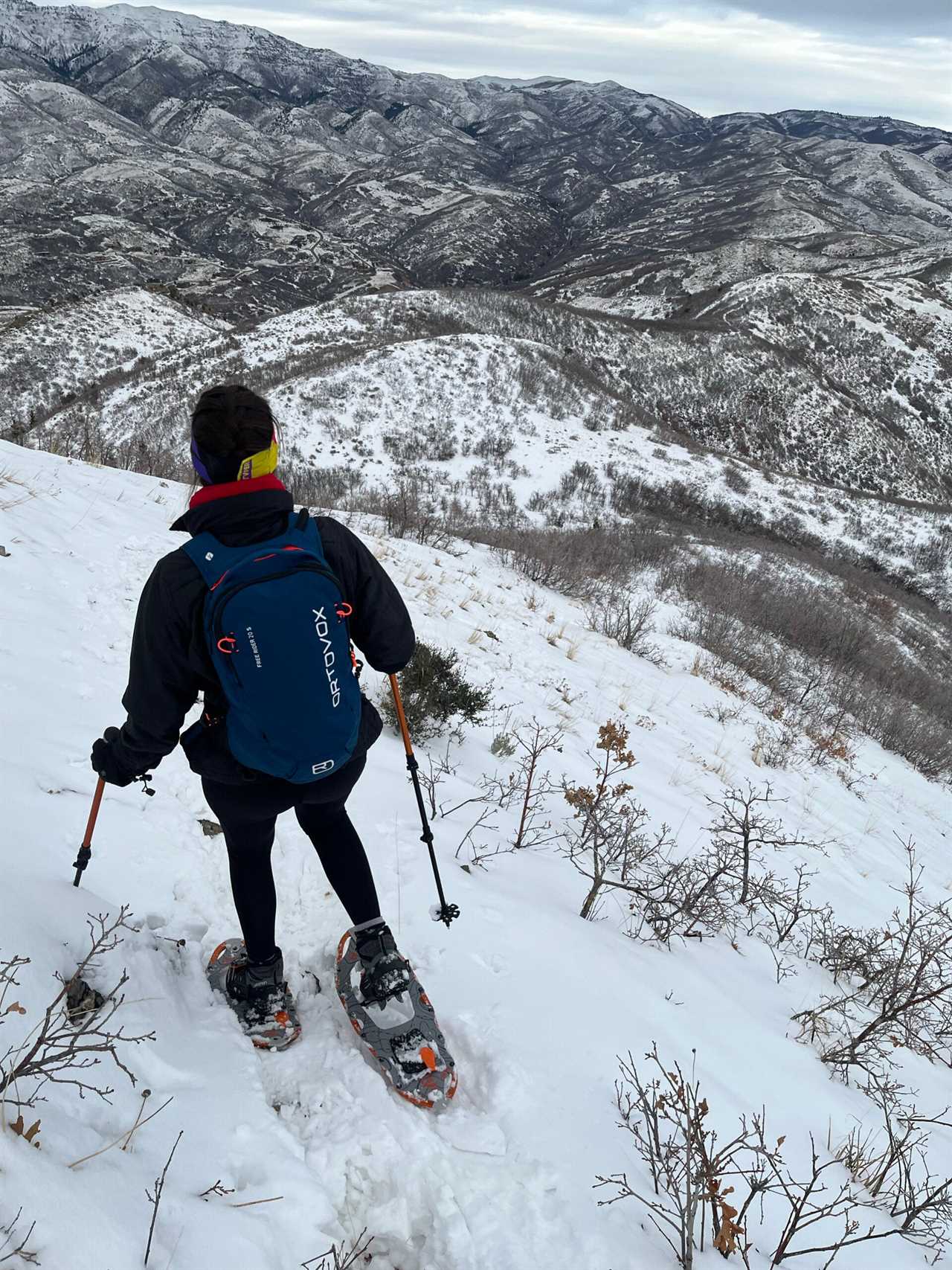
Ashley Thess
The Expedition Sno Spin Series Snowshoe Kit is great for all terrain hiking.
There is a skinny metal heel lift with a plastic tab attached for steeper trails. The tab is meant to make it easier to pull up the lift, but it is able to slide around on the bar so it is rarely in the dead-center, ideal position for it to actually operate as designed. Regardless, you can lift anywhere on the bar to raise your heel for climbing up steep terrain. The Sno Spins make a satisfying click when your lift is at full height.
These snowshoes can handle crunchy snowpack or provide grip and traction when you sink into fresh powder. The kit also comes with a carrying bag and trekking poles which must be tightened (preferably with pliers) to obtain a rigid tool. Out of the box, they will easily slide and lower when you put weight on them. —Ashley Thess
Best Backcountry Trekking Snowshoe: Atlas Range BC 26
Why It Made the Cut
The Range BC is a great backcountry snowshoe for users who want to tackle tougher terrain. They’re lightweight for deep treks, and the sawtooth frame provides great traction on steeper slopes.
Key Features
- Length: 26 inches
- Weight: 1 pound 15 ounces each
- Construction: Aluminum sawtooth frame, synthetic deck
Pros
- Lightweight
- Z-strap binding fits large mountaineering boots
- Heel lift for steep climbs
- Bindings allow shoes to nest for easy transport
Cons
- Less flotation than larger shoes
- Easier to snag on sticks and brush
The Atlas Range BC is a snowshoe for serious backcountry climbers and travelers. Rather than traditional tubing, it features a saw-tooth style frame decked with heavy-duty fabric. It’s not a huge shoe, and it’s designed more for climbing than slogging through deep powder in the flats.
The heel lift gives your calves a break on steep climbs, and the frame provides great traction. These bindings are easy to use with big mountaineering boots. When you’re not using them, the snowshoes nest nicely for easy transportation on your backpack.
The short, uplifted toes aid in climbing, and you don’t have to lift your knees as high. Though the design doesn’t float as well as other shoes, the frame bites on ice and cups the snow underneath for excellent traction.
Best Running/Racing Snowshoe: TSL Outdoors Highlander Adjust 26.5
Why It Made the Cut
The lightweight construction and versatile bindings make this snowshoe a great option for running or snowshoe racing. The high toes are designed to cushion impact without tripping you up in deep snow.
Key Features
- Length: 26.5 inches
- Weight: 2 pounds 5 ounces each
- Construction: Plastic deck, stainless steel crampons, side traction bars
Pros
- High toes won’t dive into snow
- Heel lift can be engaged with ski poles
- Adjustable bindings
- Replaceable parts

The high toes cushion impact and keep you from tripping in deep snow.
Cons
- Not the best deep-snow or general-use shoe
- Plastic frame flexes more than other shoes
If you like traveling light and fast in the backcountry, the Highlander Adjust is a great option. It’s designed for speed without getting tripped up, and the large, upswept toes help cushion impact and keep the toes from getting caught in deep snow or buried branches.
The bindings are easy to size to your boots and simple to get in and out of. On the move, you can use your ski poles to engage and disengage the heel lifts for steep climbs. The side rails and crampons provide good traction, and the smaller heels are less likely to trip you up.
Best Alpine Snowshoe: Snowfoot Olympus
Why It Made the Cut
The Snowfoot Olympus combines the grip of a mountaineering crampon with a weight-distributing polymer grate frame and gives you much-needed flotation without sacrificing grabbing-power on ultra-steep terrain in the alpine.
Key Features
- Length: 16 inches
- Weight: 1 pound 12 ounces each
- Construction: Polymer expanded grate frame and deck
- Mountaineering crampon bindings
Pros
- Secure, traditional-style crampon bindings
- Fit large mountaineering boots
- Good flotation for a small footprint
- Better for climbing steep terrain than other competitors
Cons
- Flotation lacks in deep powder
- Struggles in categories other than steep climbing
The Snowfoot Olympus is unlike any traditional snowshoe and is highly specialized for steep climbs in icy terrain. They feature adjustable binding like what you’ll find on many strap-on mountaineering crampons. In fact, these shoes feature legitimate mountaineering-style crampon teeth on front and back for a superb grip.
The frame of the Snowfoot shoes is a unique latticed grid, which reduces weight and adds stability. It also effectively creates more weight-bearing surface in a small footprint. Each cell individually grips the snow and provides better flotation than a simple flat deck surface.
The Snowfoot’s small footprint allows more natural movement and can help shorten the learning curve for steep climbing. They also excel where tight footwork is required.
Best Budget Snowshoe: Komperdell Stoic 30
Why It Made the Cut
The Stoic 30 is a classic, lightweight, and affordable snowshoe built with durable materials that will handle regular use for years.
Key Features
- Length: 30 inches
- Weight: 2 pounds 1 ounce each
- Construction: Aluminum tubing frame, fabric deck
Pros
- Lightweight, durable materials that won’t crack in the cold
- Simple bindings include heel lift
- Replaceable binding string
- Added crampon traction on heel for descents
Cons
- Bindings can work loose
- Some of my crampon lock-nuts were missing
The Stoic 30 is a no-frills classic snowshoe design that’s great for all-around use on a budget. You’ll want to size your snowshoes according to your weight, but the Stoic 30 provides great flotation in deep snow and works well for both trail walking and breaking/packing.
You can tighten the flexible binding with a simple string, and the rear strap tightens independently. While the front and rear straps aren’t the most efficient, they’re simple and repairable should the strings wear out or break.
The deck uses a durable and flexible fabric that won’t get stiff and crack in extreme cold, and the crampon section at the heel is a serrated scoop-shape and that provides traction when going straight downhill. On the deck, small crampon teeth are attached via small bolts and lock-nuts, but several of the nuts were loose or missing in my package, so make sure to check them before using.
Best Snowshoes for Beginners: Crescent Moon Eva Foam Snowshoes
Why It Made the Cut
The Eva Foam snowshoes were the easiest snowshoes to use that I tested. The simple hook-and-loop bindings are intuitive and effective, and the shoes are great for beginners to learn snowshoeing.
Key Features
- Length: 24 inches
- Weight: 1 pound 12 ounces each
- Construction: Foam deck/frame, hook-and-loop bindings
Pros
- Easy to use
- Lightweight
- Great for trails
Cons
- Not great for deep powder
- Traction isn’t great for climbing
The Eva Foam snowshoe is a simple and effective design. A flexible foam deck surrounds a harder plastic plate that features traction stud screws for ice. The binding is a simple sandal-style hook-and-loop system that’s easy and comfortable to wear.
This snowshoe is swept up at both the heel and toe, which makes it easy to walk naturally without tripping. The foam deck provides good traction for packed trails, but it’s not as good for steep climbs in the powder.
This is a great snowshoe for the beginner at a good price. For someone interested in snowshoeing or walking groomed trails, these are tough to beat.
Best Snowshoes for Kids: Crescent Moon Kids Snowshoes
Why It Made the Cut
Simple and easy is the name of the game when it comes to snowshoeing with kids. These shoes are simple and intuitive for kids to use, so they can start having fun immediately.
Key Features
- Length: 18 inches
- Weight: 13 ounces each
- Construction: Foam frame and deck, hook-and-loop binding
Pros
- Bindings are easy to get on/off
- Good flotation
- Traction studs don’t hang up as much as traditional crampons
Cons
- Traction isn’t great on steep climbs in soft snow
The foam kid’s snowshoes from Crescent Moon are some of the most user-friendly and fun snowshoes on the market. Kids can easily put them on and use them naturally, and they provide good flotation. The hook-and-loop bindings accommodate a wide variety of kids boot sizes, and the screw studs make it easy for kids to walk without tripping.
Methodology
There’s a lot of snow in Interior Alaska this year, and my family and I tested these snowshoes around our property in about 30 inches of snow. Normally our snow is loose and sugary, but this year we have a crust layer about 15 inches down, so walking without snowshoes is awful. But these snow conditions helped determine how well different shoes floated and distributed their weight.
We used the snowshoes on untouched snowpack, packed trails, and steep uphill and downhill slopes to test traction. The sub-zero temperatures helped show how well materials should hold up and how difficult or easy bindings are to manipulate in the cold.

Consider your priorities—like uphill traction or floatation in powder—when you start shopping for snowshoes. Tyler Freel
FAQs
Q: What is the best snowshoe brand?
There are several high-quality brands of snowshoes, the best brand for you will depend on your individual size and applications. If you’re smaller in stature and want snowshoes for running on trails, you’ll need a completely different snowshoe than a tall, heavier person who needs snowshoes for breaking trail in deep powder. It’s better to prioritize your needs over the brand name when it comes to finding the best snowshoes.
Q: Are snowshoes one size fits all?
Most snowshoes have adjustable bindings that are technically one size fits all. However, some bindings don’t fit all large men’s winter boots so be sure to check. Because a snowshoe might be rated for certain shoe-sizes, it doesn’t necessarily mean that they will fit your winter boots. Snowshoes are also sized based on individual weight ratings. They’re meant to provide a certain amount of flotation that supports a certain bodyweight. If you’re heavier, you’ll generally need larger snowshoes.
Q: How do I choose the right snowshoes?
Your size/bodyweight, boot size, and intended use will determine the right snowshoes for you. Snowshoes are each designed for applications like trail hiking, running, powder trekking, and more. Find the right kind of shoe by application first, then select the size of snowshoe that most-closely matches your size and boots.
Final Thoughts
The best snowshoes for you depends on your size, the conditions where you’ll use them, and how you plan to use them. There are tons of great snowshoes on the market and taking your individual needs into account will help you decide which of these options is best for you, even if you find something else that works better.
The post Best Snowshoes of 2023 appeared first on Outdoor Life.
Articles may contain affiliate links which enable us to share in the revenue of any purchases made.
By: Tyler Freel
Title: Best Snowshoes of 2023
Sourced From: www.outdoorlife.com/story/gear/best-snowshoes/
Published Date: Fri, 25 Feb 2022 16:00:00 +0000
----------------------------------------------
Did you miss our previous article...
https://manstuffnews.com/weekend-warriors/european-hunters-are-switching-to-thermal-optics-the-trend-is-coming-to-america-next
 Backyard GrillingWeekend WarriorsAdvice from DadBeard GroomingTV Shows for Guys4x4 Off-Road CarsMens FashionSports NewsAncient Archeology World NewsPrivacy PolicyTerms And Conditions
Backyard GrillingWeekend WarriorsAdvice from DadBeard GroomingTV Shows for Guys4x4 Off-Road CarsMens FashionSports NewsAncient Archeology World NewsPrivacy PolicyTerms And Conditions
